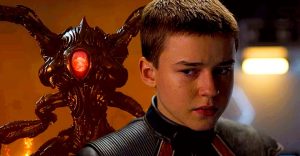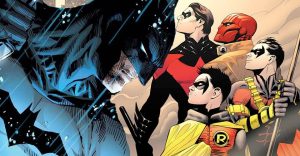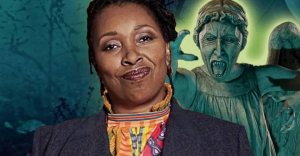Lord of the Rings: 15 Things You Never Knew About Ents

The Lord of the Rings is perhaps the richest fantasy text in existence, and it’s one that has undoubtedly influenced every story that came after it. One of the largest aspects of that influence comes in the form of the many beasts that J.R.R. Tolkien created to inhabit Middle Earth; creatures that have been riffed on and straight-up stolen in the years since. One of the more interesting of these creatures comes in the form of the Ents– the tree shepherds charged with defending the forests of Middle Earth.
Ents are pivotal to the story told in The Lord of the Rings, as they are ultimately responsible for the destruction of Isengard and the downfall of Saruman. Still, there’s much about their history that the films don’t reveal, and even the book trilogy doesn’t give you all the information you might want to know. With that in mind, here are 15 Things You Never Knew About Ents.
15 How They Created Treebeard

Much of The Lord of the Rings was remarkably life-like when it was adapted to the screen. Although the films are almost 15 years old now, the special effects still largely hold up, and that’s certainly true of the effects that were used to create the most famous Ent of all. Treebeard was created using a combination of an animatronic model and CGI.
It’s this combination of elements that makes Peter Jackson’s film depiction seem so realistic. The animatronic model gives Treebeard a lifelike sense of motion that can be enhanced by CGI. It’s this lesson about CGI that Jackson seemed to have forgotten in The Hobbit trilogy, which was much heavier on CGI than its predecessor, much to those films’ detriment. Treebeard represents an impressive feat of special effects, especially for the period in which he was created, and it’s a feat that still holds up against a great deal of the CGI today.
14 Ent Comes from the Latin Word for Giant

Although Tolkien applied the word specifically to the tree-like creatures he created, the word “ent” can actually be used much more generally to describe all sorts of mythic giants, including trolls, giants and other humanoid creatures. In a sense, then, “ents” are actually among the most common creatures found in fantasy works, even though the word is used more specifically in Lord of the Rings.
Of course, Tolkien used the word correctly in describing his creatures, which are nothing if not gigantic. It’s the sheer size of the Ents that makes them so initially terrifying, and it’s also what gives them so much power to shape the story. These Ents tower over the forests they are tasked with protecting, and cover vast swathes of land with every step. Ents may be fairly peaceful creatures normally, but their massive size suggests that there’s a lot of power hidden behind their friendly faces. Just ask poor Saruman.
13 There are More than Two Ents With Names

While very few people know it, there are quite a few Ents, each of which has a distinct name. Treebeard is the oldest of the Ents, but Skinbark and Leaflock were also among the first Ents created during the First Age, and are some of the oldest creatures in Middle Earth as well. Leaflock has become treeish in his old age, while Skinbark lived in the mountains near Isengard, and was wounded when the orcs ravaged the area.
Of course, there are other Ents named during Lord of the Rings as well. Quickbeam was much younger than Treebeard during the War of the Ring, and received his name because of his unusually quick decision-making process. There’s also Beechbone, who was burned by Saruman’s devices, and Filmbrethil, Treebeard’s wife, who was lost when all the Entwives disappeared. Each of these Ents provides color for Ent society, and ultimately suggests the very real culture that these tree shepherds have.
12 Johnathan Rhys-Davies Voices Treebeard

John Rhys Davies had the chance to portray characters of vastly different sizes in The Lord of the Rings film trilogy. Davies played the dwarf Gimli, and it’s the role that he’s most readily recognized for. Far fewer people know that Davies also provided the voice of Treebeard, which you can just make out if you know it’s Davies. Of course, Gimli and Treebeard don’t actually share any screen time in the films, so it was fairly easy to mask the similarity in the pair’s voices.
In Treebeard and Gimli, Davies got the chance to play two very different characters, and not just physically. Gimli serves largely as comic relief, but also represents the values at the core of Dwarf society. Treebeard is also a representative for a particular culture within Lord of the Rings, but he’s much more stoic than Davies’ other character. Still, Davies is the only actor who can claim credit for two of Lord of the Rings most iconic characters, and that’s pretty cool.
11 Ents Resemble Huorns

It may seem safe to assume that all tree-like creatures inhabiting Middle Earth are Ents, but that’s far too easy for Tolkien. Instead, there are Ents, the magical creatures tasked with guarding the forests, and Huorns, a separate but related group of creatures that can speak to Ents and are capable of motion, but are unable to be understood by other living creatures. It’s unclear whether Huorns are former Ents who have planted roots, or whether they are trees that become “Entish.”
Unfortunately, Treebeard is rather scarce on specific details about Huorns. In the Lord of the Rings trilogy, Merry believes that there are many Huorns in the darkest spots of Fangorn Forest. These Huorns are capable of shrouding their movements in darkness, and are something of an intermediary between trees and Ents. Unlike Ents, Huorns may also exist outside of Fangorn Forest; in the Old Forest some trees like Old Man Willow appear to talk and move.
10 Ents Perceive Time the Way Trees Do

Perhaps the best example of the way Ents see time is their three day Entmoot, which comes in The Two Towers when the Ents are trying to determine whether they should take action against Isengard, and the crimes that Saruman committed against trees. For the Ents, this moot was considered quite hasty, and many among them believed that deliberations should have lasted far longer. Still, it’s probably good that the Ents didn’t take any longer than three days, considering the serious threat that Isengard posed.
In the long run, it’s likely a positive to have creatures in the world that can take a longer view of the world’s changes than humans are typically granted. Ents see things change and evolve, and they understand the way things shift or remain the same over time. They have perspective, and it’s a valuable view of the world that many have trouble grasping simply because of the shortness of human life.
9 Ents Don’t Die, They Just Become “Treeish”

While it’s true that Ents experience time much more slowly than humans, they do age, albeit slowly. What this means, of course, is that Ents must eventually reach a point in their life when they can no longer do the thing that Ents were created to do: protect trees. Because Ents resemble trees so closely, they don’t exactly die when they reach old age. Instead, they simply plant roots in a single spot, and become “treeish.”
Even after they’ve stopped moving, Ents remain sentient. They remain aware of the world around them, and are able to communicate both with trees and with other Ents.
It is said that, after a long enough period, Ents may lose their ability to communicate, and simply transform into trees completely. It’s unclear exactly how long this process takes, but it is clear that Ents age incredibly slowly, as Treebeard has outlived almost everything else in Middle Earth without becoming “Treeish.”
8 Ents Have a Widespread Cultural Influence

Like many things within the world that Tolkien created, the Ents have planted roots throughout popular culture, and have led to the creation of many similar beasts throughout its history. Perhaps most notably, everyone’s favorite Guardians of the Galaxy character owes quite a bit to the existence of Treebeard. Groot, the tree-like creature in both the films and comic books that’s only capable of saying its own name, is almost certainly an offshoot of the type of creature that the Ents directly inspired across pop culture.
Of course, Groot is far from the only example of a creature that takes inspiration from the Ents. Others include characters in Warcraft, Skylanders, Dungeons & Dragons, and a character in C. S. Lewis’s Chronicles of Narnia series. The influence of the Ents speaks to the overall power of Tolkien’s books, which have greatly impacted fantasy as a genre, and all of pop culture more generally.
7 During the Third Age, Ents are Only Known to Exist in Fangorn Forest

Ents once roamed over broad swathes of Middle Earth, but in the time of the War of the Ring, they are only known to exist inside of Fangorn Forest, where our heroes come across them. It’s this old forest that terrifies Aragorn and company, and forcing them to fear the worst about the hobbits that they’ve been tracking. The Ents are ultimately fairly harmless, but that initial fear is definitely warranted.
While the Ents have already been confined to existence within a single forest, they’ve also seen that forest almost completely obliterated by Saruman and the orcs at Isengard, who use the trees as fuel for their mechanized army. The last march of the Ents represents something of a final stand for the race, which has seen its population slowly decimated by a number of factors. The ancient forest of Fangorn makes for a fitting setting for that final battle, and comes to represent all that the Ents were once proud of.
6 They Learned to Speak From the Elves

Since their creation at the hands of Yavanna, the goddess of fauna and flora, Ents were sentient beings, and were capable of free thought. It wasn’t until the elves arrived in Middle Earth that they learned to speak, though. Of course, the Ents didn’t have to wait that long to learn to speak, because the elves arrived in Middle Earth at roughly the same time that the Ents were first created by Yavanna.
Language probably isn’t of the utmost importance for Ents, whose primary duties involve communication with trees, but the ability to speak is integral to their presence in The Lord of the Rings trilogy. For their part, elves were always interested in helping other races, which becomes most clear when they choose to ally themselves with men in the battle against Sauron. Although they ultimately leave Middle Earth, elves certainly had an enormous influence on the the way this particular world developed.
5 The Last March of the Ents is Based on Macbeth

The biggest moment for the Ents in the entire Lord of the Rings trilogy is their last march, when they decide that Saruman needs some payback for the years of abuse he’s handed to the trees that the Ents defend. Apparently, Tolkien’s idea for this massive attack came from one of the prophecies in Macbeth, which stated that Macbeth would not be defeated unless the trees themselves rose against him. In the end, MacDuff cut down trees to provide cover for his army as it advanced.
Tolkien explained that he was disappointed that the trees themselves did not literally rise out of the ground, and so he decided to right that wrong during the last march of the Ents. The filmed adaptation of this moment is filled to the brim with spectacle, and ranks among the best moments of the entire trilogy. Saruman was no longer feared the way he once was, and that’s all because the trees rose against him.
4 Ents Often Come to Resemble the Trees they Shepherd

Ents are responsible for shepherding trees, but the line between the trees and the Ents often gets blurred with the passage of time. While Ents generally exhibit many of the characteristics of trees, including their incredibly strong skin, their ability to erode stone, and their vulnerability to fire and the blows of an axe, it’s also the case that specific Ents can resemble the specific trees that they shepherd and protect.
Quickbeam, for example, guards Rowan trees, and also resembles them. He’s tall, slender, smooth-skinned, and has green-grey hair. You often hear that pets and owners grow to resemble one another, and it appears that Tolkien attempted to make this connection explicit in his design of the Ents.
What’s remarkable about each Ent is the detail put into each one. They’re all distinct from one another, both physically and in their personalities. Each one is unique, and it’s clear that Tolkien wanted them to be more than trees.
3 There are no Young Ents Because of the Disappearance of Entwives

Entings, or young Ents, appear to be completely absent from The Lord of the Rings trilogy, and there’s a reason for that—the female Ents, or Entwives, have disappeared. Originally, Ents and Entwives reproduced and were happily engaged in their protection of the trees. Eventually, many of the Entwives became fond of teaching and performing agricultural duties that didn’t directly align with the overall goals of the Ents.
In pursuit of these agricultural goals, the Entwives gradually moved further and further away from the Ents. They would still return to the Ents to mate, but were lost after Sauron destroyed the lands that they inhabited. Based on sightings from hobbits and comments from Treebeard, there are some theories which suggest that the Entwives eventually settled in the Shire.
After the conclusion of Return of the King, Aragorn promises that the forests will expand again and the Ents will be able to resume their search for the Entwives, but Treebeard thinks it’s unlikely they will find them.
2 Treebeard is the Oldest Living Thing in Middle Earth

There’s actually some debate about whether Treebeard or Tom Bombadil is older, but Treebeard certainly claims the title, and there’s plenty of evidence suggesting it may be true. For one, Treebeard himself claims to be the oldest thing in Middle Earth, and Gandalf seems to support that claim. Treebeard is certainly a wise creature, and his discussions with Merry and Pippin seem to suggest that he had lived through a great deal.
It’s this age that makes Treebeard so hesitant to involve the Ents in the War of the Ring at all. He knows that Ents have historically remained neutral in conflicts between outside parties, but he and the other Ents ultimately come to the realization that they can’t sit on the sidelines any longer. Treebeard’s age also helps him to understand that he shares this world with other beings, and that he must fight for it along side them. He convinces the other Ents to do the same, and the rest is history.
1 They Were Created Because of the Dwarves

Though they definitely don’t resemble one another in size, the histories of Ents and dwarves in inextricably linked. Aulë, the god who created the dwarves, was countered by his wife Yavanna, who saw the damage the dwarves could do to the natural world if they were left unchecked. As a result, Yavanna decided to create the Ents, a race of tree-herders who were capable of defending the trees against those who may wish to cut them down.
Of course, there are plenty of environmental messages tucked inside of the entire trilogy, and the Ents are a continuous conduit for these messages. They defend the forests, and are outraged by the industrial, brutal world that Saruman represents. The lovable dwarves represent a less radical version of industry, one that can be balanced by the presence of noble, exceedingly large tree shepherds. It’s all about balance, and the Ents and the dwarves work to level the playing field for one another.
—
Do you have any trivia to share about the Ents from The Lord of the Rings? Drop it in the comments!

















